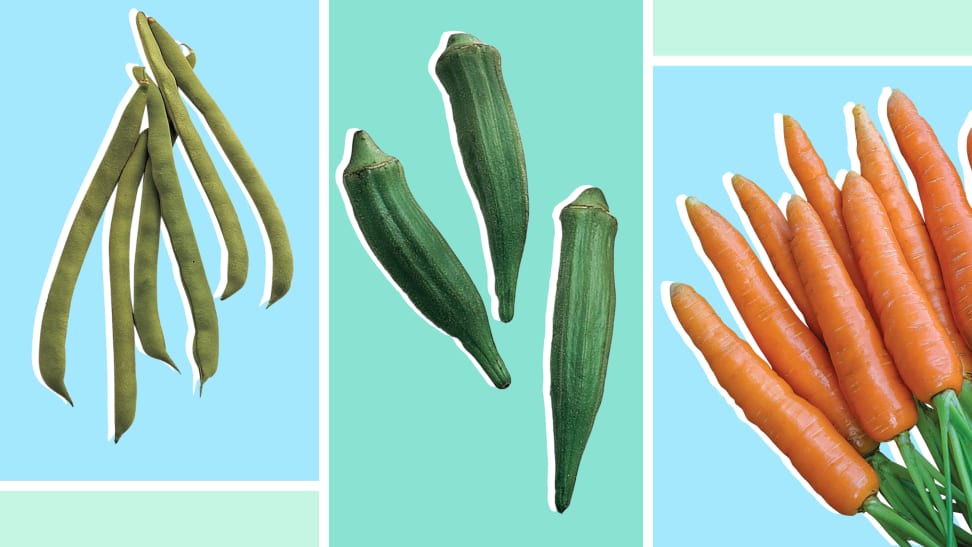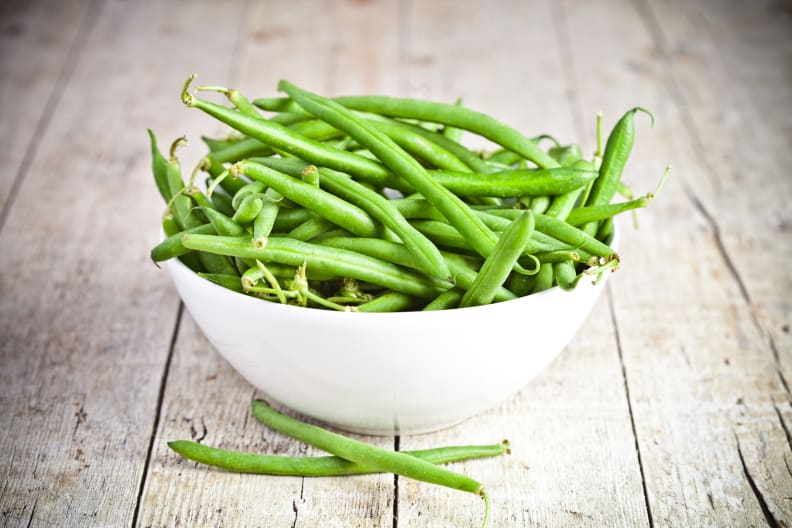10 seeds you can still sow in time for a summer harvest
It’s not too late to plant a delicious garden
 Credit:
Reviewed / Burpee
Credit:
Reviewed / Burpee
Recommendations are independently chosen by Reviewed's editors. Purchases made through the links below may earn us and our publishing partners a commission.
Whether you’re interested in growing your own herbs or are looking for a way to combat grocery store inflation, it’s not too late to start a summer garden in your backyard. Ahead of the cooler weather, there is still plenty of sunshine left to grow tasty fruits, veggies, and herbs in planters, pots, and flower boxes on your wood deck, outdoor patio, or apartment balcony.
Ready to get growing? Here are 10 fast-growing seeds to kickstart your summer garden.
1. Beans of different varieties

Beans are a healthy and hearty food to grow at home.
Green beans, also called snap beans, love warm weather and grow fast—and you can keep planting them every two weeks until 50-60 days before the end of your growing season (your local first frost date) for a continuous crop. If you’ve got space on the ground, try this three color bush bean blend to get green, yellow, and pretty purple beans ready seven weeks after planting.
If you have time, but not space, Kentucky Wonder pole beans are a classic, tasty heirloom that have been grown by happy gardeners for almost 150 years. They’re ready in 65 days, and they need a fence or trellis for their 6-foot vines to cling to, like this bean tower trellis, or a bamboo cane holder for quick and easy cone-shaped bean support.
2. Beets

Grow fresh beets in your backyard.
Beets are a double-duty plant, with edible greens and sweet roots, and you can harvest them in about 60 days. Although they’re known as a cool-climate crop, beet seeds are most likely to sprout when the soil is 85°F, making them a perfect summer crop.
If you’re in a hurry, you can harvest Early Wonder beet greens in 20 days, and mature (if small) beets in 45 days. Chioggia beets are double-colored—an Italian heirloom variety with red and white stripes. Or choose Forno beets for cylindrical roots to make uniform slices.
3. Carrots

Carrots are a crunchy summer snack.
Good for snacking, soups, juicing, carrots are a feel-good vegetable for pretty much everyone, and they’ll germinate in soil up to 95°F. Practice your French by planting Scarlet Nantes carrots, which grow to eight inches long in 75 days, or plant with rainbow with Burpee’s Kaleidoscope Mix, which yields tasty carrots in red, purple, yellow, orange and white.
4. Herb varieties like basil and cilantro

Don't forget about fresh herbs to enhance your next home-cooked meal.
While herbs technically don't fit the summer vegetables theme, they are a quick-growing plant that you can harvest ahead of fall—and many fresh herbs pair nicely when plated with other veggies from your garden. You can use an indoor garden to grow herbs year-round, but there’s nothing quite like the experience of growing herbs fast from seed. Herbs like cilantro, basil, and parsley thrive in both backyards, raised garden beds, and containers.
Cilantro is a versatile herb that matures in about 50 days. In the summer, try slow-bolting cilantro so you can harvest it before it flowers (this can cause it to have a funny taste). Sow a new row every week for a continuous harvest.
Parsley is a little slower to grow and takes 70 days or more to reach its full potential, but you can always harvest the leaves a little early. Try the Italian large leaf or the triple curled varieties for garnishes.
Basil enjoys warm soil (about 70°F or higher), and you can start harvesting leaves when the plants are young by pinching off the top two leaves to encourage branching (this helps the plant produce more). Harvest full-sized leaves in 60 days. Try Genovese basil for a classic Italian pesto, and Thai basil for basil with a spicy touch of licorice.
5. Cucumbers

Cucumbers are great for picking, in salads, and more.
Like herbs, cucumbers are also technically classified as a fruit. But cucumbers are another fast-growing garden edible that grows best in temperatures up to 105°F and produces a tasty harvest in just 45 to 55 days. There are plenty of varieties available container growing, like Spacemaster, which grows vines just 2-feet long, and aptly-named Patio Snacker.
6. Greens like collards, spinach, and lettuce

You can grow salad-ready lettuce in a planter, pot, or raised garden bed.
Lettuce tends to fade as the days grow longer, but sturdy cooking greens can thrive in summer heat. Vates collards resist both bolting and frost, in case you’re planting a little late in the season, and mature into 24-inch plants in 65 days. Bright Lights chard makes a garden spectacle on red, orange, yellow and green stems and matures in 55 days.
Bloomsdale spinach is one leafy green that’s known for resisting bolting, and Burpee produces a Heatwave lettuce mix that will improve your chances.
7. Kohlrabi

If you've never had this one, give it a try! You won't regret it.
One of the less-familiar vegetables, kohlrabi plants are related to broccoli, but are grown for their sweet, crisp, cabbagey underground bulbs. They’re commonly used for salads, but also can be roasted or added to soups and are ready for harvesting in 55 days. Choose Burpee’s Sweetie Hybrid Mix for a purple and green root vegetable extravaganza, or Early White Vienna for a more understated look.
8. Okra

Okra seeds thrive in hot weather.
Okra sprouts at high temperatures, prefers soil that’s 75°F or warmer, and grows fast (56 days) for Clemson spineless. You can add some color to your garden by growing Red Burgundy okra, which has a deep, warm, rhubarb-red color. Harvest the pods when they’re three inches to four inches for frying or gumbo. Remember to stake your plants because okra commonly grows 6-feet tall or more. You can use a tomato cage or any other type of tomato plant support system.
9. Radishes

Enjoy a tasty radish harvest with your summer salad.
You grew them in kindergarten in paper cups–and adults can grow radishes too. The ultimate in vegetable fast food, radishes are ready to pick in as little as three weeks. Cherry Belle are plump, round red radishes, while French Breakfast radishes are a little longer and milder.
10. Zucchini

These can grow really tall, so harvest them at the right time!
It’s the summer squash everyone loves to make fun of until they eat ratatouille, zoodles, zucchini bread, or zucchini frittata. Zucchini is easy to grow, and matures in about 55 days and everything you hear about zucchini’s prolific yields is true. Harvest the fruit when they’re eight inches long (or smaller) to avoid having baseball-bat-sized zucchini to give away.
Black Beauty is the classic sprawling plant with long, slender zucchini, while Round zucchini is shaped like little bowling balls. If you tend to miss green zucchini growing in the shadows of green leaves, grow pale yellow Chiffon squash instead.
Tips for growing a summer garden
Different seeds sprout and grow best at different temperatures. Heat stress (temperatures over 95°F during the day and over 70°F at night for extended periods) can cause tomatoes, peppers, beans, and zucchini to drop their flowers before pollination takes place, keeping fruit from ripening. Some veggies like broccoli, Brussels sprouts, cabbage, and cauliflower won’t grow at all in high temperatures.
If the place you live is on the cool side, particularly if nighttime temperatures are still under 50°F, use a soil thermometer to take the temperature of the ground. If you’re looking at a long, hot spell in the next month, protect heat-sensitive plants with a shade cloth for plants that blocks hot sun, especially in the afternoon.
The product experts at Reviewed have all your shopping needs covered. Follow Reviewed on Facebook, Twitter, Instagram, TikTok, or Flipboard for the latest deals, product reviews, and more.
Prices were accurate at the time this article was published but may change over time.



